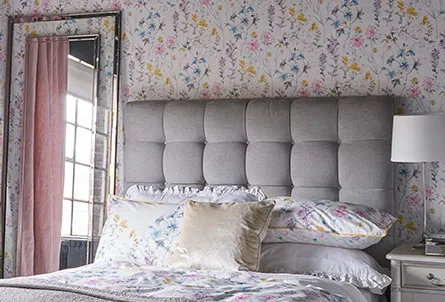Our shelves have different designs, styles and types of wallpaper and are regularly updated to reflect the newest trends as well as traditional designs that stand the test of time. Browse our shelves or take a look through our wallpaper books. We stock quality wallpaper brands such as Crown Wallcoverings & Fine Decor.



Not sure how much paper you need? Our fully trained staff can help you make sure you’re not caught short – just bring along your wall dimensions.
Special Order Wallpaper from our Wallpaper Books typically arrive into store within 7 days.
Check out our guide to choosing the perfect paper for you below.
WALLPAPER TYPES:
Vinyl Wallpaper is commonly used in high moisture areas such as bathrooms and kitchens as they are resistant to steam and condensation. Tough and washable, these papers have a thick vinyl layer which make them more hardwearing than standard paper. These wallpapers are also perfect for high traffic areas where wipe clean will be useful (e.g playrooms).
Standard wallpaper, a thinner, less hard wearing paper usually used in living rooms and bedrooms, these papers have no wall vinyl covering so are not moisture resistant. Standard papers are flat and texture free so can be easily painted over, but also come in a range of colours and patterns.
Blown vinyl wall coverings add texture and pattern to walls and are somewhere between a standard paper and a vinyl in terms of durability. The thicker, more textured surface also serves as extra insulation and are great for covering wall imperfections. Generally used for living rooms and bedrooms, blown vinyl is available in a range of colours and patterns or in ready to paint plain whites.
Heavy Italian Vinyl, Ideal for feature walls, are a more traditional and classic style of wall covering that are usually heavily embossed with opulent patterns and textures. Again, great for hanging on imperfect walls due to their thickness, they are very durable and come in a range of finishing’s.
CHOOSING YOUR WALLPAPER:
First, consider the design you are looking for – are you looking to make a bold statement with pattern and colour or are you looking for a plainer design to serve as a muted background to a room? If you are stuck for ideas, interior design magazines, adverts and the internet are great for inspiration – bring these with you when you are choosing.
Next, make sure that your paper will fit with your existing furniture, accessories and décor by collecting colour and fabric samples or photographs of your furniture as a guide.
The use of the room as well as the condition of the walls are also important to choosing a type of paper. For high moisture rooms like kitchens and bathrooms, a more durable and water resistant vinyl will be more appropriate. The thickness of the paper is also important depending on the state of the walls. Smoother walls with less imperfections can take a thinner paper – whereas a thicker paper may be needed for more damaged surfaces.
PREPPING YOUR WALLS FOR PAPERING:
To get the best possible surface for your wallpaper, the wall needs to be prepped before hanging. Walls must be as clean, dry and smooth as possible for the optimum finish. It is also advisable to size the walls using a mixture of powdered wallpaper paste. Fill in any holes and cracks using polyfilla or similar and smooth out any rough areas that may be making the surface uneven.
It is best to hang wallpaper over bare walls rather that over an older layer or scraps of paper. However, for more textured or damaged walls, a heavy-duty lining paper can be used to even out and cover any imperfections.
TOOLS FOR PERFECT PAPERING:
Hanging Wallpaper or vinyl can be tricky and you will need the right equipment for best results.
Wallpaper Paste: The adhesive used to hang the paper on the wall surface. Ready made pastes or powdered versions that need to be mixed with water are available. TOP TIP: Always read and follow packet instructions as the wrong consistency will affect the result
Pasting Table: Provides a flat, level surface to lay paper for pasting and prevent paste getting on household tables or carpets. Most are folding for easy storage when not in use.
Pasting Brush: A specialist pasting brush has thicker bristles than a standard paintbrush and is worth investing in for a smooth paste distribution. TOP TIP. Make sure to wipe down the table surface between each sheet length as any spilt paste or mess can affect the next length.
Level: Needed to ensure that markings and sheets are even and to prevent wonky lines.
Pencil: For marking borders and edges to position your paper.
Measuring Tape: Needed for getting accurate sheet sizes.
Knife/Scissors: For trimming sheets to size. You can buy specialist Paperhanging Scissors designed for cutting wallpaper. TOP TIP Weigh down the end of the paper to prevent curling whilst cutting and use a ruler or straight table edge to achieve a straight edge.
Bucket of clean water and sponge: To remove excess paste from the paper and for clearing up any spills.
Our website is designed as a digital shop window. This gives you a snapshot of what we stock in store but is not designed to replace the in-store experience. If you would like to check information on our website or stock levels of a certain product you can fill in an enquiry form or call the Cirencester Store on 01285 626442